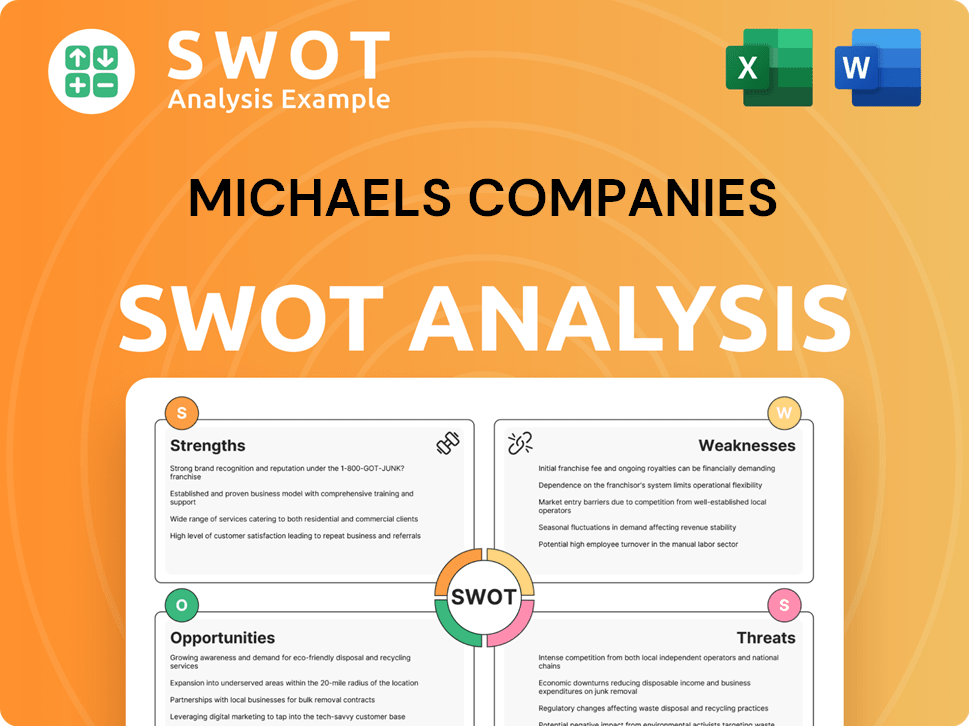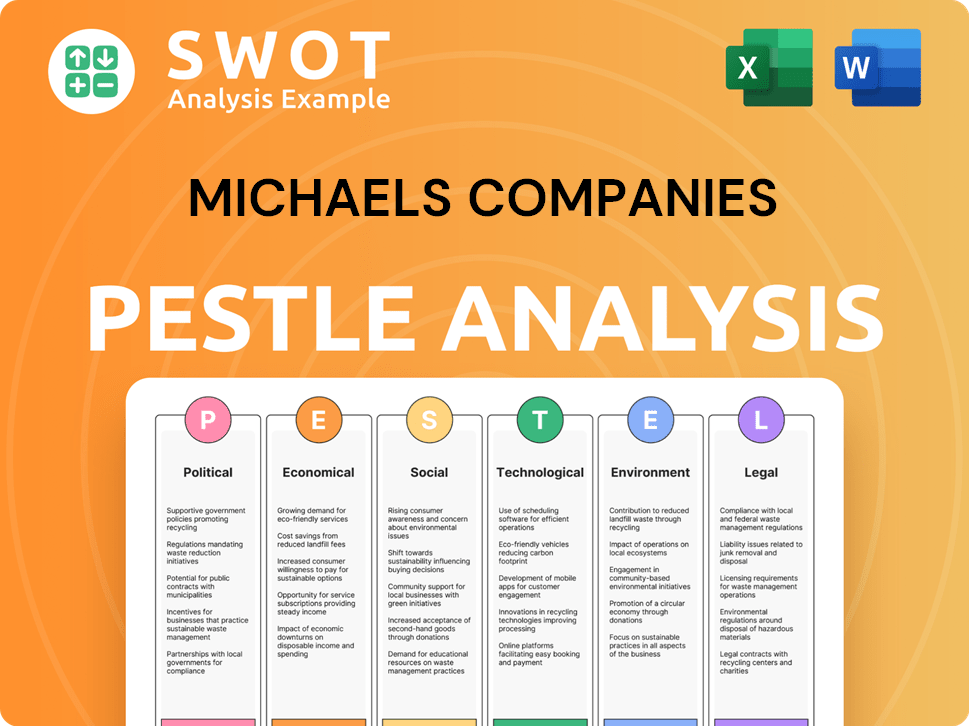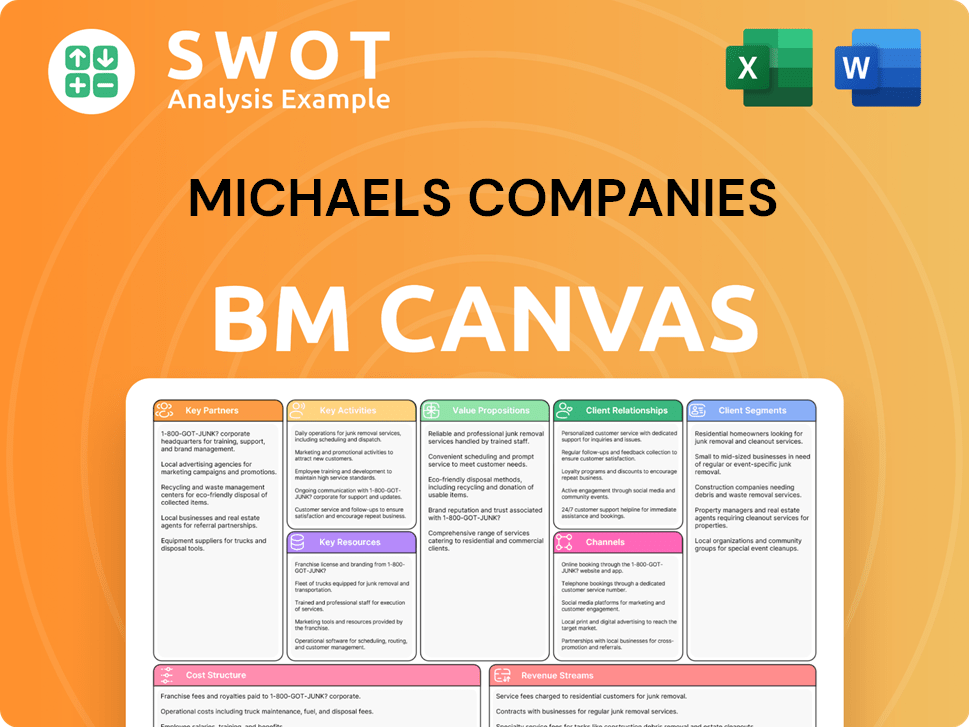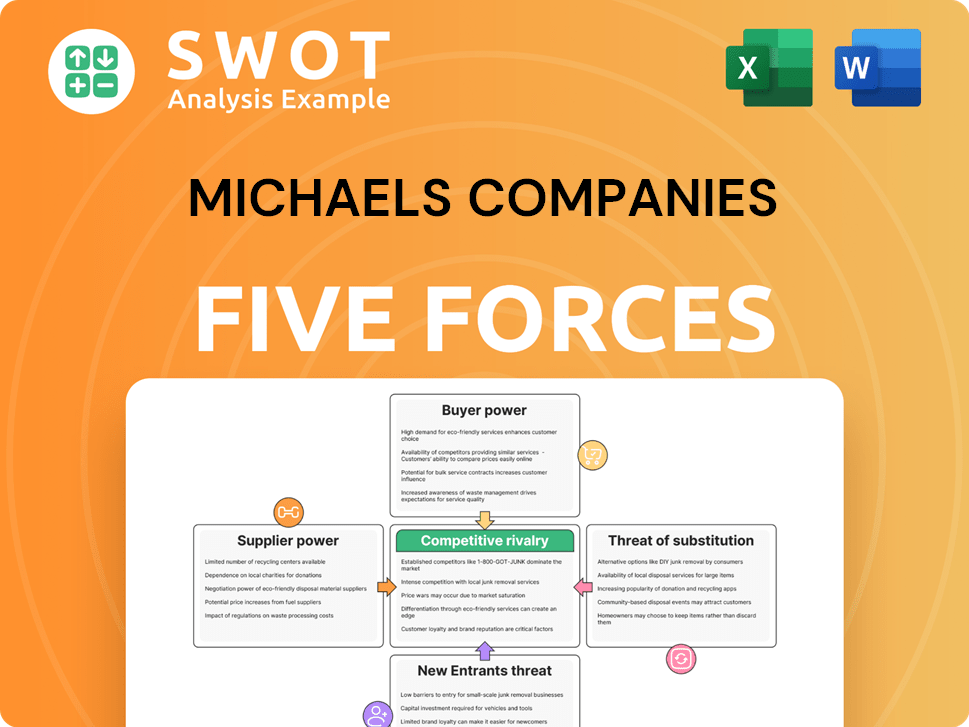Michaels Companies Bundle
How has Michaels Companies shaped the arts and crafts world?
From a single store in Dallas, Texas, to a retail empire spanning North America, the story of Michaels Companies is one of remarkable growth and adaptation. Founded in 1973, this arts and crafts retailer has become a household name, synonymous with creativity and DIY projects. But what were the key moments that transformed a small business into a craft store chain with a market capitalization of billions?

This article delves into the brief history of Michaels, exploring its origins and the Michaels founder's vision. We'll examine the Michaels timeline, from its early years and store opening dates to its significant milestones and acquisitions. You'll discover how Michaels Companies evolved, its impact on the arts and crafts industry, and its current status as a leading retailer. For a deeper dive into the company's strategic positioning, consider exploring our Michaels Companies SWOT Analysis.
What is the Michaels Companies Founding Story?
The story of the Michaels Companies began in 1973 in Dallas, Texas, with businessman Michael J. Dupey at the helm. He transformed a struggling Ben Franklin five-and-dime store into an arts and crafts establishment. This marked the beginning of a dedicated retail space for creative supplies.
Dupey's vision filled a market gap, offering a focused destination for hobbyists and DIY enthusiasts. This initial business model centered on providing a diverse selection of materials for various creative projects. This strategic move set the stage for the company's future expansion.
In 1982, Sam Wyly, a Dallas businessman, acquired a controlling interest in Michaels. By then, the company had grown to 11 stores, generating approximately $10 million in annual revenues. Following this acquisition, Dupey established MJ Designs, another craft retail chain that was later acquired by The Michaels Companies. The Michaels Companies went public in 1984, trading on NASDAQ under the newly formed parent entity. At the time of the IPO, Michaels operated 16 stores. This early funding and expansion were crucial for Michaels' growth and market leadership. To know more about the company's marketing tactics, check out the Marketing Strategy of Michaels Companies.
Here's a quick look at the key moments in Michaels' history.
- 1973: Michael J. Dupey founds Michaels in Dallas, Texas.
- 1982: Sam Wyly acquires a controlling interest.
- 1984: Michaels becomes a publicly traded company.
- Early expansion and growth within the arts and crafts retail sector.
Michaels Companies SWOT Analysis
- Complete SWOT Breakdown
- Fully Customizable
- Editable in Excel & Word
- Professional Formatting
- Investor-Ready Format

What Drove the Early Growth of Michaels Companies?
The early years of the arts and crafts retailer, Michaels Companies, were marked by rapid growth and strategic expansion. Following its founding, the company quickly established itself as a key player in the retail market. This period saw significant increases in store numbers, sales, and geographical reach, setting the stage for future developments in the Michaels timeline.
By the end of 1990, the Michaels store chain had expanded to 140 stores, with sales reaching $362 million. During this time, the company successfully reduced its debt from $34 million to $9 million. This financial restructuring was a key factor in supporting the company's further growth.
In 1993, Michaels expanded its geographical footprint, opening stores in Ohio, Virginia, Oklahoma, Washington, and Iowa. This year also marked the company's first international venture with the opening of two stores in Toronto, Canada. The expansion into Canada was a strategic move to broaden its market presence.
Further expansion occurred in 1994 through acquisitions of craft stores in the Pacific Northwest, including Treasure House Crafts, Oregon Craft & Floral Supply, and H&H Craft & Floral. In the Midwest and Northeast, Michaels acquired Leewards Creative Crafts, a chain comprising 101 stores. In addition to these acquisitions, Michaels opened 32 new stores on its own in 1994, contributing to sales reaching $995 million.
In 1995, Michaels continued its store expansion and diversified its retail concepts by acquiring Aaron Brothers Holdings, Inc., a specialty framing and art supply store with 71 units. By 1996, Michaels' sales reached $1.4 billion, though the company reported a significant loss of $31 million for the year, indicating challenges despite revenue growth. In 2000, Michaels ventured into wholesale operations, and in 2002, it introduced 'Village Crafts by Michaels,' a smaller-store format. The company's strategic shifts during this period included focusing on operational efficiencies and exploring new retail formats and sales channels.
Michaels Companies PESTLE Analysis
- Covers All 6 PESTLE Categories
- No Research Needed – Save Hours of Work
- Built by Experts, Trusted by Consultants
- Instant Download, Ready to Use
- 100% Editable, Fully Customizable

What are the key Milestones in Michaels Companies history?
The history of Michaels Companies is marked by significant milestones, including ownership changes and strategic expansions, reflecting its evolution as a leading arts and crafts retailer. From private equity buyouts to going public and then private again, the company has navigated various market conditions while expanding its store footprint and online presence.
| Year | Milestone |
|---|---|
| 2006 | The company was taken private in a $6 billion leveraged buyout by Bain Capital and The Blackstone Group. |
| 2008 | Michaels Stores celebrated the opening of its 1,000th store. |
| 2014 | Michaels returned to being a public company under the newly formed parent entity, The Michaels Companies. |
| 2020 | Ashley Buchanan, formerly of Walmart, was appointed CEO, leading to new store concepts. |
| 2021 | Michaels became a private company again after a $5 billion offer from Apollo Global Management. |
| 2023 | Debuted MakerPlace by Michaels, an online marketplace connecting makers with shoppers. |
| 2024 | Unveiled its first-ever Creativity Trend Report, identifying six key crafting trends for 2025. |
Innovations at Michaels have included the launch of 'Martha Stewart Crafts' in 2007, providing online crafting resources. More recently, the company has focused on enhancing customer experience with new store layouts and digital platforms like MakerPlace.
In May 2007, Michaels launched 'Martha Stewart Crafts,' an online resource offering how-to instructions, projects, and crafting products, a collaboration with Martha Stewart. This initiative expanded the company's offerings beyond physical stores.
Under CEO Ashley Buchanan, Michaels introduced new store concepts featuring open layouts and 'inspiration hubs'. These new concepts included maker space areas for instruction and self-service pickup lockers for online orders.
During the COVID-19 pandemic, Michaels enhanced its omnichannel offerings. This included curbside pickup and same-day delivery to meet the surge in demand for crafting supplies.
In late 2023, Michaels debuted MakerPlace by Michaels, an online marketplace. The marketplace was designed to connect makers with shoppers, expanding its digital presence.
In March 2024, Michaels unveiled its first-ever Creativity Trend Report. This report identified six key crafting trends for 2025, reflecting crafting's growing mainstream appeal.
Challenges for Michaels include a soft retail market and potential impacts from global import tariffs, particularly given its supply chain exposure to China. In the fiscal year ended February 1, 2025, Michaels reported a 1.8% revenue decrease, attributed to a 2.4% decline in comparable sales.
Michaels faces challenges from a generally soft retail market. This has impacted the company's overall sales and financial performance.
The company is exposed to potential impacts from global import tariffs, particularly given its substantial supply chain exposure to China. These tariffs could affect the cost of goods.
In the fiscal year ended February 1, 2025, Michaels reported a 1.8% revenue decrease. This decline was primarily attributed to a 2.4% decrease in comparable sales.
Michaels is implementing mitigation initiatives to address these challenges. These include diversifying its supply chain, negotiating with vendors, and adjusting product assortments and pricing.
Michaels Companies Business Model Canvas
- Complete 9-Block Business Model Canvas
- Effortlessly Communicate Your Business Strategy
- Investor-Ready BMC Format
- 100% Editable and Customizable
- Clear and Structured Layout

What is the Timeline of Key Events for Michaels Companies?
The Michaels Companies, Inc. has a rich history, evolving from a single store to a leading arts and crafts retailer. The company's journey, marked by strategic acquisitions, expansions, and shifts in ownership, reflects its adaptability to market trends and its commitment to serving the maker community. From its humble beginnings in 1973 to its current status, Michaels has consistently aimed to provide a comprehensive platform for creativity. Learn more about its Revenue Streams & Business Model of Michaels Companies.
| Year | Key Event |
|---|---|
| 1973 | Michael J. Dupey founded Michaels in Dallas, Texas. |
| 1982 | Sam Wyly acquired a controlling interest in Michaels, which had 11 stores and $10 million in annual revenues. |
| 1984 | Michaels became a publicly traded company on NASDAQ, operating 16 stores. |
| 1993 | Michaels expanded internationally with two stores in Toronto, Canada. |
| 1995 | Michaels acquired Aaron Brothers Holdings, Inc., adding a specialty framing and art supply chain. |
| 2006 | Bain Capital and The Blackstone Group acquired Michaels Stores for $6 billion, taking it private. |
| 2007 | Michaels launched 'Martha Stewart Crafts' in collaboration with Martha Stewart. |
| 2008 | Michaels opened its 1,000th store. |
| 2014 | The Michaels Companies became a public company again. |
| 2020 | Ashley Buchanan became CEO; Michaels introduced new store concepts with 'inspiration hubs' and 'maker spaces.' |
| 2021 | Apollo Global Management acquired Michaels for approximately $5 billion, taking the company private again. |
| Late 2023 | Michaels debuted MakerPlace by Michaels, an online marketplace. |
| March 2024 | Michaels unveiled its first-ever Creativity Trend Report, highlighting emerging crafting trends for 2025. |
| April 2025 | S&P Global Ratings placed Michaels' ratings on CreditWatch Negative due to tariff risks and potential impact on profitability and cash flow, despite improved operating margin and cash generation in fiscal 2023. |
| May 2025 | Michaels launched new baking & entertaining private label collections and celebration offerings. |
Michaels is concentrating on its 'Maker Strategy' to strengthen its position as the go-to source for creativity. This involves enhancing its retail foundation and modernizing the omnichannel experience. The goal is to re-establish itself as the expert brand in the arts and crafts retailer market.
Digital Commerce 360 projects Michaels' total web sales in 2025 to reach $1.06 billion. This growth highlights the company's focus on expanding its online presence and providing convenient shopping experiences for customers. The online market is crucial for the future of Michaels store.
The company is actively diversifying its supply chain away from China. This is a strategic move to mitigate the impact of rising tariffs and maintain profitability. This diversification is essential for long-term financial stability.
Despite a projected revenue decline of approximately 1% in 2024 due to constrained discretionary spending, Michaels is adapting. The company is adding new product offerings, lowering prices, and opening new stores to attract customers. This is a key to the future of the Michaels store.
Michaels Companies Porter's Five Forces Analysis
- Covers All 5 Competitive Forces in Detail
- Structured for Consultants, Students, and Founders
- 100% Editable in Microsoft Word & Excel
- Instant Digital Download – Use Immediately
- Compatible with Mac & PC – Fully Unlocked

Related Blogs
- What is Competitive Landscape of Michaels Companies Company?
- What is Growth Strategy and Future Prospects of Michaels Companies Company?
- How Does Michaels Companies Company Work?
- What is Sales and Marketing Strategy of Michaels Companies Company?
- What is Brief History of Michaels Companies Company?
- Who Owns Michaels Companies Company?
- What is Customer Demographics and Target Market of Michaels Companies Company?
Disclaimer
All information, articles, and product details provided on this website are for general informational and educational purposes only. We do not claim any ownership over, nor do we intend to infringe upon, any trademarks, copyrights, logos, brand names, or other intellectual property mentioned or depicted on this site. Such intellectual property remains the property of its respective owners, and any references here are made solely for identification or informational purposes, without implying any affiliation, endorsement, or partnership.
We make no representations or warranties, express or implied, regarding the accuracy, completeness, or suitability of any content or products presented. Nothing on this website should be construed as legal, tax, investment, financial, medical, or other professional advice. In addition, no part of this site—including articles or product references—constitutes a solicitation, recommendation, endorsement, advertisement, or offer to buy or sell any securities, franchises, or other financial instruments, particularly in jurisdictions where such activity would be unlawful.
All content is of a general nature and may not address the specific circumstances of any individual or entity. It is not a substitute for professional advice or services. Any actions you take based on the information provided here are strictly at your own risk. You accept full responsibility for any decisions or outcomes arising from your use of this website and agree to release us from any liability in connection with your use of, or reliance upon, the content or products found herein.